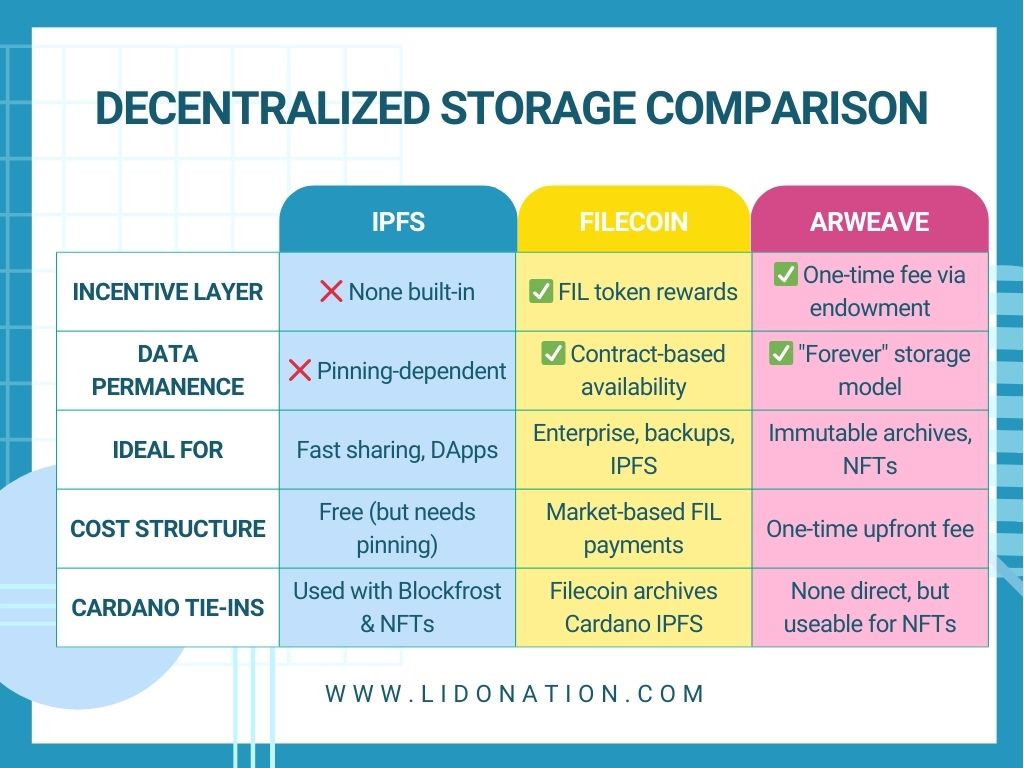Last time, we wandered through the Inter-Planetary File System (IPFS)—a place where files live not on a centralized corporate server farm, but in a vast, open garden tended by everyone. We saw how IPFS reshapes the way files are tended and harvested, offering resilience, speed, and censorship resistance.
But this wild garden has a flaw: without gardeners, seedlings may wither. In IPFS, without someone willing to “pin” a file, it can quietly vanish. There’s no built-in reward to keep files alive, no promise that your treasured uploads will survive the seasons. The IPFS garden is built on goodwill—and goodwill, beautiful as it is, doesn’t always pay for hard drives and uptime.
That’s where the next chapter begins.
To build a farm that can weather the ages we need more than just planting. We need caretakers, incentives, and long-term stewardship.
Enter Filecoin and Arweave: two visions for how to grow the decentralized web from fleeting blossoms into a lasting, living ecosystem.
Filecoin: Building a Marketplace for Memory
The first great answer came from close to home. Protocol Labs, the creators of IPFS, introduced Filecoin in 2020. Filecoin offered a plan to solve the incentive problem with a decentralized marketplace.
In Filecoin’s world, storage is no longer a favor; it’s a business. “Miners” don’t just volunteer to host data—they get paid. Using proofs called Proof of Replication and Proof of Spacetime, Filecoin miners prove they’re storing files correctly and earn rewards in Filecoin’s native currency, $FIL. Clients can negotiate storage contracts, and retrieval miners can earn extra by serving files on demand. All of this incentivizes uptime, verifiability, and scalability, making it appealing for enterprise-level or mission-critical storage.
Decentralization, meet capitalism.
Instead of trusting in goodwill alone, Filecoin trusts in incentives—the idea that people will reliably care for data if it’s in their interest to do so. It worked. Today, Filecoin’s network spans hundreds of petabytes of storage, supporting everything from NFT archives to enterprise backups.
But the world is a big place, with lots of good ideas in it. Let’s look at yet another chapter of the decentralized storage story.
Arweave: Chasing Immortality
Where Filecoin built a marketplace, Arweave dared to build a monument.
Founded in 2017, Arweave took a different approach: What if you could upload something once, and it would be preserved forever?
No contracts, no ongoing payments, no negotiations. Just permanence, paid up front. Arweave’s innovation was the Blockweave, a blockchain-like structure where miners must prove they can access old data in order to add new blocks. Instead of ongoing payments, Arweave collects a one-time fee when data is uploaded. That money seeds an endowment, designed to pay for storage costs over decades or even centuries.
This vision is less like a day in economics class, and more like an archive for the ages– —a digital Library of Alexandria, minus the fires.

Cardano’s Quiet Guardians
Cardano-heads are often proud of “our chain”. Level-headed aficionados may talk a good talk about interoperability, and claim not to be Cardano “Maxis.” But behind closed doors, we might secretly think that Cardano’s academically rigorous foundations are really the best in show.
However, without most users even realizing it, these decentralized storage systems help safeguard important elements of the Cardano universe. When you mint an NFT on Cardano, there’s a good chance the metadata lives first on IPFS. But to ensure it doesn’t drift away, platforms like Blockfrost archive this data on Filecoin—offering stronger guarantees that your NFT will still tell its story years or decades from now. Lido Nation used Arweave for our first NFT project – “A Day at the Lake.” We went with Arweave at the time because they offer long term storage (up to 200 years) for the same price you may pay for 2 to 3 months of pinning with an ipfs service provider. Arweave is also closer to being a “blockchain for storage” compared to IPFS.
Conclusion
The decentralized web was never just about breaking free from corporations—it was about building something better, something that could survive the storms of time. IPFS gave us the seeds. Filecoin and Arweave built the greenhouses, the orchards, and the archives. Together, they form a layered ecosystem where memories—art, knowledge, history—are no longer trapped in centralized vaults. They can live out in the open, protected not by any single entity, but by a web of incentives, innovations, and shared hope.




No comments yet…